This week, we seek the science of Architecture. We find out how rapid prototyping technology could help us print out entire houses, and how natural light and ventilation could cut our energy bills. Plus, giggling gorillas tell us how laughter evolved and birds that learn from their neighbours. In Kitchen Science, Dave challenges you to build the best bridge, using only a single sheet of A4 paper!
In this episode

Giggling Gorillas and Chuckling Chimps
Laughter is a wonderful thing to hear - but would you recognise it coming from anything other than a human?
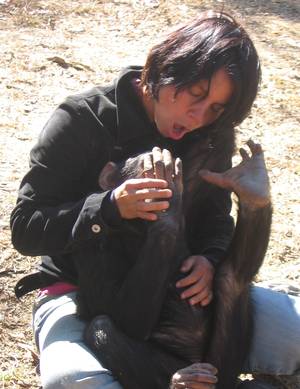 In a delightful study published in this week's Current Biology, Marina Davila-Ross and colleagues at the University of Plymouth have found that what we think of as laughter today could have evolved in our common ancestor with the apes, between 10 and 16 million years ago.
In a delightful study published in this week's Current Biology, Marina Davila-Ross and colleagues at the University of Plymouth have found that what we think of as laughter today could have evolved in our common ancestor with the apes, between 10 and 16 million years ago.
To test this out, they have been listening to the sounds that were made by 21 young apes when they were tickled, and comparing them to the sounds of a human baby being tickled. These sounds were then subject to an acoustic analysis that could detect similarities and differences between the sounds, and importantly judge how closely related the sounds were.
All in all, they analysed 829 recordings, and looked at 11 different acoustic aspects of these sounds, such as peak frequency, the range of frequencies, the number of calls in a bout etc. They also looked at whether the sounds were made on the inhale, exhale or both.
| Gorilla Laughter | Bonobo Laughter |
| Chimpanzee laughter | Human Laughter |
They found a number of similarities, but also some key differences. It turns out that we humans are much noisier than our ape cousins, as the human babies produced significantly more 'voiced' sounds - these are sounds that clearly come from regular vibration of the vocal cords. The human babies also only laughed on the exhale, while the other apes could laugh both when breathing in and out. They were surprised to see that, while laughing, Chimps and Bonobos could effectively control the rate at which they breathe out - that might not seem surprising, but it was thought t be a uniquely human adaptation that allows us to speak.
 Interestingly, the differences seen for human babies were not one end of a spectrum - these aspects were consistent for the other apes and otherwise, it was actually pretty difficult to tell one species from the next.
Interestingly, the differences seen for human babies were not one end of a spectrum - these aspects were consistent for the other apes and otherwise, it was actually pretty difficult to tell one species from the next.
Next, they put all the data together to create a family tree of laughter and it fit extremely well with a phylogenetic tree, one that shows how closely related species are. Siamang and Orang-utan laughs were more similar to each other than to the other apes, as were Chimps and Bonobos, and humans laugh more like the chimps than the other apes.
It's all too easy to fall into the trap of ascribing human thoughts and intentions to animals - we call it anthropomorphism - but this paper now shows that when an ape is laughing - it's okay to call it a laugh.
But remember don't anthropomorphise animals - they don't like it...
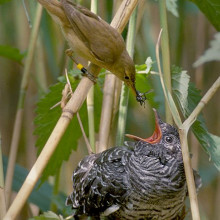
11:56 - Warblers Learn who to Trust
Warblers Learn who to Trust
Back in February, I reported on a paper in the journal Current Biology about how Reed Warblers protect themselves from being parasitised by cuckoos...
Now, in a follow up paper published in this week's Science, Nick Davies and Justin Welbergen from Cambridge University have found out how the birds learn how to defend themselves by watching their neighbours.
Cuckoos are a problem because they lay their eggs in other bird's nests, and then leave the host birds to bring up their young. This wastes a lot of energy for the reed warblers, but there's no advantage for them. As a result, they've evolved a tendency to mob cuckoos, which makes them less likely to end up bringing up someone else's chicks, even though it's a costly behaviour in terms of energy and it risks exposing the Warblers to predators.
Well when the Warblers mob, they make very loud calls and snap their beaks with a loud clicking sound. They also swoop down at the cuckoos, directly attack them and generally get in a flap.
In the new paper they present evidence as to how the Warblers learn when to mob, and when not to mob - as it's a bad idea to waste your efforts mobbing a bird that isn't a threat. Armed with a model of a cuckoo and a model of a parrot (acting as a novel but non threatening stimulus), they set about observing how different birds responded to each.
After establishing a baseline for how each set of birds reacted, they allowed the birds they studied to see how neighbouring birds reacted to the models. If the birds are learning through social stimulus, they said, then mobbing would only increase in response to the model that their neighbours mobbed.
They found that when the neighbouring birds mobbed a model parrot, it made no difference to how likely the focal birds (the ones being studied) were to mob either the cuckoo or parrot models. However, when a cuckoo was mobbed nearby, the rates of cuckoo mobbing greatly increased.
In fact, the naive birds that did not mob a cuckoo on their first exposure started mobbing only after watching their neighbours do so. This is probably because female cuckoos have a certain area in which they will lay eggs, and so a cuckoo in a neighbour's nest suggests a realistic threat.
This suggests that the Warblers are primed to learn new behaviours only when they respond to genuine threats - a tendency also seen in macaques, who learn to be scared of snakes, but can't be taught to be afraid of rabbits!
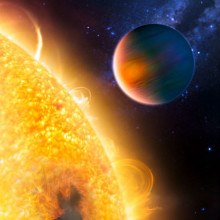
15:34 - The Gruber Prize for Cosmology
The Gruber Prize for Cosmology
with Robert Kennicutt, Director of the Institute of Astronomy at the University of Cambridge
Ben - Also in the news this week, the winners of the Gruber Prize for Cosmology have been announced. This is the tenth anniversary of the Cosmology Prize, and this year it's shared between three winners:
Wendy Freedman - director of the Observatories of the Carnegie Institution of Washington in Pasadena, California
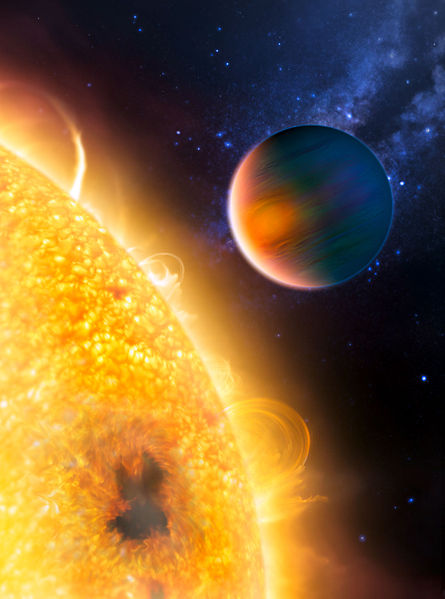 Jeremy Mould, professorial fellow at the University of Melbourne School of Physics.
Jeremy Mould, professorial fellow at the University of Melbourne School of Physics.
And Robert Kennicutt, Director of the Institute of Astronomy at the University of Cambridge in England.
They're sharing the $500,000 prize for leading the teams that measured the value of the Hubble constant - the rate at which the universe has been expanding since the Big Bang.
We're joined by Professor Robert Kennicutt now. Hi, Robert. Thanks for joining us.
Robert - Thank you. Happy to be here.
Ben - You must be really pleased to see your work recognised by such a prestigious award.
Robert - Indeed. The phone call was quite a surprise but the work was very influential. It was done about ten years ago. I think the organisers of the prize were waiting to see if we'd gotten the right answers or not. In any case, it was delightful to have it recognised in the way it was.
Ben - I can imagine. What is so important about this number, the Hubble constant.
Robert - Yeah. The measurement actually ties into the whole series of experiments that your listeners have probably heard about over the last decade to try to characterise the expansion history of the universe. Our measurement actually provides some very basic numbers: how large is the universe? What is the distance scale? In fact it actually provides a measurement of the age of the universe. Moreover when you combine it with other measurements of the supernova, high red shift, it actually was the work that provided this strong evidence for dark energy in the universe and this expansion. These experiments all tie together and yield consistent results. This was one of the cornerstones of that series of experiments.
Ben - Without this research we wouldn't be asking the questions that we're asking today. It really was a major step forward in understanding out universe.
Robert - That's right. I can give a simple analogy. The measurements that established the existence of dark energy actually tell us how the expansion rate of the universe has changed. It actually slowed down and has sped up over time whereas we're measuring the absolute scale. It's actually a difficult measurement. For example, if you've looked at the television in the last couple of days you've seen the images of Barack Obama standing next to Nicholas Sarkozy and Gordon Brown. You can instantly when you look at the screen tell which of these people is the tallest. Obama is the tallest and you can even get, when they stand next to each other, get some idea whether he's 20% taller or 10% taller. It's very difficult when looking at the monitor to have some idea how tall these people actually are; whether Obama's six feet tall or six-and-a-half, five foot eight and so on. That's our experiment - really to see by measuring relatively nearby galaxies and providing the yardstick next to these galaxies to measure the exact distance, the quantitative distances and the scale of this whole expansion.
Ben - Will it also help us to understand what the ultimate fate of the universe will be. If we can understand its history then surely we can predict a little bit more about its future.
Robert - Indeed. Prior to this work these distances were only known to a factor of 2 accuracy. The best measurements of the time gave an age of the universe, derived from the expansion, was younger than the ages of the oldest stars we could measure using other techniques. The result of these measurements, combined with the more distant supernova cosmology experiments, actually led to several independent measurements of the cosmic age scale. We've actually determined the problem and remarkably these measurements have come into almost exact concordance and it's almost unsettling, in fact. Scientists, especially astronomers, are not used to precise agreement. The term "precision cosmology," which is a new term is something we're still getting used to. The result of that is - the implication of that is the universe of the future's actually going to speed up its expansion over time as this dark energy becomes more and more important a force in driving the expansion of the universe.
Ben - So how did your teams actually measure it? It seems like a difficult thing to come up with.
 Robert - It actually boils down fairly mundane elements. What we want to do is survey distances to galaxies. We want to measure how far they are away in miles and kilometres precisely. The key instrument that enabled this breakthrough was the Hubble Space Telescope. The key technique we use is a class of variable pulsating stars called cepheid variable stars whose brightness can be measured accurately when you measure their period of oscillations. Hubble actually had the resolution to be able to identify these stars in galaxies at distances of up to 50 or 100,000,000 light years. A light year is six trillion miles. These are vast distances. We essentially laid out twenty benchmarks in distances in the local universe. We were able to measure not only the local expansion but how that expansion actually changes with distance. We live in an over-dense part of the universe that has affected the local expansion. We had to calibrate that out as well. So you can think of this sort of as being surveyors laying out benchmarks and establishing a scale. The result was accurate to about 10% at the time. Since then other techniques using cosmic microwave background have repeated their measurements completely independently and the two sets of results actually agree within a few per cent. We're quite sure we've got it right.
Robert - It actually boils down fairly mundane elements. What we want to do is survey distances to galaxies. We want to measure how far they are away in miles and kilometres precisely. The key instrument that enabled this breakthrough was the Hubble Space Telescope. The key technique we use is a class of variable pulsating stars called cepheid variable stars whose brightness can be measured accurately when you measure their period of oscillations. Hubble actually had the resolution to be able to identify these stars in galaxies at distances of up to 50 or 100,000,000 light years. A light year is six trillion miles. These are vast distances. We essentially laid out twenty benchmarks in distances in the local universe. We were able to measure not only the local expansion but how that expansion actually changes with distance. We live in an over-dense part of the universe that has affected the local expansion. We had to calibrate that out as well. So you can think of this sort of as being surveyors laying out benchmarks and establishing a scale. The result was accurate to about 10% at the time. Since then other techniques using cosmic microwave background have repeated their measurements completely independently and the two sets of results actually agree within a few per cent. We're quite sure we've got it right.
Ben - That's astounding. So finally, the prize money shared between the three of you - will that go into more scientific research or are you planning a well-deserved treat?
Robert - You're not the first person to ask. These important decisions take time, you must understand.
Ben - Of course!
Robert - I'm not going to buy a supercar. I'm not going to give it all to charity but we are going to spend some of it on one major party for the team.
Ben - Wonderful. Just in case you happen to be doing the invites at the moment you can write to The Naked Scientists at Cambridge University. But no, of course, we wouldn't expect an invite...
Robert - I don't know. I'm a fan of the show so who knows!?
Ben - Wonderful. I'll keep an eye on the post. Thank you so much for joining us, Robert. That was Professor Robert Kennicutt, he's the Director of the Institute of Astronomy at Cambridge University and along with Wendy Freedman and Jeremy Mould he's just been awarded the Gruber Foundation's Cosmology Prize for measuring the rate of expansion of the universe.
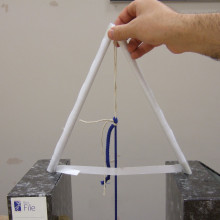
Building Bridges - The Science of Beams
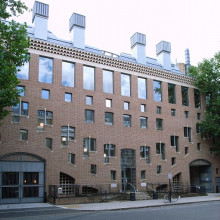
34:33 - Natural Ventilation for Low-Energy Buildings
Natural Ventilation for Low-Energy Buildings
with Shaun Fitzgerald, Masterclass in Energy Supply and Demand, BP Intsitute
Helen - We join Meera Senthilingam who's been out in London this week in search of another way to make buildings more efficient...
Meera - In the UK today forty to fifty per cent of our energy is consumed by buildings. Buildings that use air conditioning typically use double the amount of energy as ones that don't. One way to reduce consumption is by producing naturally ventilated buildings which don't need air conditioning to keep them cool. This week I'm at the School of Slavonic and Eastern European Studies campus at University College London. In 2005 this building was constructed and designed as a low-energy building. With me this week is one of the senior researchers that helped design the building: that's Shaun Fitzgerald from the BP Institute. So Shaun, this building was designed to have natural ventilation? What does this mean and why does it help keep a building cool?
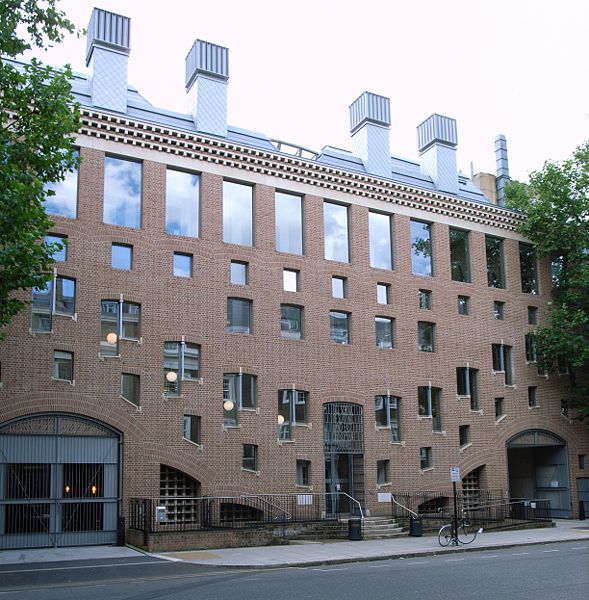 Shaun - A naturally ventilated building is one which is trying to use the forces of nature to get air from within the building to without and actually distribute the air within the building as well. We're looking at wind and buoyancy as one of the driving forces. A mechanically ventilated building uses fans and a mechanically ventilated building would have one where the windows are not open-able so you have to use fan power throughout the year. When you look at the amount of energy that we are using with fans compared to wind and buoyancy the numbers are staggering.
Shaun - A naturally ventilated building is one which is trying to use the forces of nature to get air from within the building to without and actually distribute the air within the building as well. We're looking at wind and buoyancy as one of the driving forces. A mechanically ventilated building uses fans and a mechanically ventilated building would have one where the windows are not open-able so you have to use fan power throughout the year. When you look at the amount of energy that we are using with fans compared to wind and buoyancy the numbers are staggering.
Meera - We're standing outside the building and just looking at it it's reasonably large and it's got what look like four, what look like, metal chimneys on the top. What are these as part of the design?
Shaun - So the chimneys on the front of the building are exhaust chimneys. They are there to try and allow the hot air that's been generated within the building to be extracted. It's using, in this case, mainly buoyancy to drive that air. Those chimneys are to remove the hot air and the odours associated with that hot air in the building.
Meera - As well as the chimneys located on the top of the building what else has been incorporated into the design of this School of Slavonic Studies to keep the airflow moving?
Shaun - One of the big challenges for a building in the middle of The City is the intake air. The intake air has got associated with it, if you open vents at a low level, there is an ingress of noise from a noisy street such as the one we're on. Secondly it's to do with air quality. The fumes from taxis and cars can be easily drawn into buildings. If you can create openings at high level and bring the fresh air in from high level you can overcome both of those challenges. Twenty metres up in the air, twenty-five metres up in the air the actual dirty air syndrome isn't as difficult as it is down at street level. In this particular building the air intake path at high level feeds an atrium. The atrium is large, relative to some of the other chimneys that we've got around the perimeter of the building. The air intake path is through the centre of the building. This is to help provide acoustic treatment of the air just using the natural fabric of the building. It's just glass.
Meera - So we're just going to move inside now to have a look at this atrium and understand how it works.
So we've entered the building now and there is a central atrium which is very large, running through the core of the building. It's six stories high and the shape is an equilateral triangle, of which the sides are probably about five-six metres long. Shaun, this is a very large atrium.
Shaun - It's a wonderful centre of the building architecturally and it provides a number of functions as well. Firstly you'll notice that the daylight provision within the middle of the building is significant but it's not bright, direct sunlight. It's a background, diffuse radiation so it's a lovely sunlight that we're getting into the building. Obviously the second function that we cared about as engineers is this is the air source for the building. You'll see that around the perimeter of the building on every floor there are a number of open-able windows. If you look closely these windows have got a chain attached to them and a motor. These are motor-driven actuators to control most of the opening area between the atrium and each of the occupied spaces - the office and the library.
Meera - How does this atrium and the chimneys on the top of the building all work together in order to keep cool air flowing through this building?
Shaun - The building ventilation works primarily because there is heat being generated within the library and the offices through lights, I.T. equipment and people. The heat that is generated from that source will ensure that any fresh air that comes into the space is reduced in density. It therefore becomes buoyant and it will rise out through the perimeter chimneys, the chimneys that are around the backside of the building. We now have a U-tube effect where fresh air is being pulled in through the middle of the atrium at external temperature conditions in through these windows where it is then heated and the hot air rises out through the front of the building. It's using the heat within the building to generate the airflow; the airflow itself managing the temperature build-up within the building.
Meera - There are actually sensors within the building that are in action in order to control how many things need opening. What are the sensors and what are they looking at?
Shaun - the sensors in this building are temperature and carbon dioxide. The challenges of ventilating a building are to make sure there is enough fresh air coming in. The proxy that we use is the CO2 level in a building. The second function is to make sure it isn't too hot in the building. Both of those parameters: internal temperature, carbon dioxide levels are used by a control system to regulate the amount of opening area of these open-able windows that we have.
Meera - We are in London so it doesn't actually get hot that much during the year. It's generally colder than it is hotter. So what about during winter when the weather's cold outside?
Shaun - When the weather's cold outside the same strategy is deployed for this building but as the fresh air comes in through this atrium you'll notice in front of all of the opening windows there is a radiator. The radiator in this building is being used to preheat the incoming air. On a moderately cold day most of the heat being delivered to that air will be by the lights, the heat, the people and the I.T. equipment.
Meera - this building did open back in 2005. Have there been any other newer buildings being developed which are slightly better designed?
Shaun - One of the things which I think have been the Achilles heel of these wonderfully naturally ventilated buildings is the fact that we've been using radiators to preheat the incoming air. But, if one looks at the amount of heat generated within modern buildings we find that it's considerable and easily enough to maintain the interior at an adequate level of 21 degrees C for all but the coldest days. That technology will allow naturally ventilated buildings to have even lower energy consumption levels than the ones such as this exemplary building that we're in today.
Helen - That was Shaun Fitzgerald from the BP Institute in Cambridge talking to Meera Senthilingam.
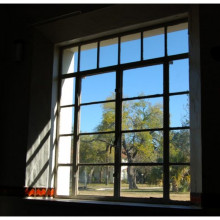
41:37 - Thermal shutters
Thermal shutters
with Professor Stephen Gage, UCL
A feature we are going to look at in the future of buildings is controlling the natural light that comes into a building and the heat which is lost through all the different surfaces. Now Stephen Gage is a professor of innovative technology at University college London and he is investigating the use of thermal shutters to control the amount of light that enters a building an also the amount of heat that is lost.
Helen - What made you come up with the idea for thermal shutters in the first place?
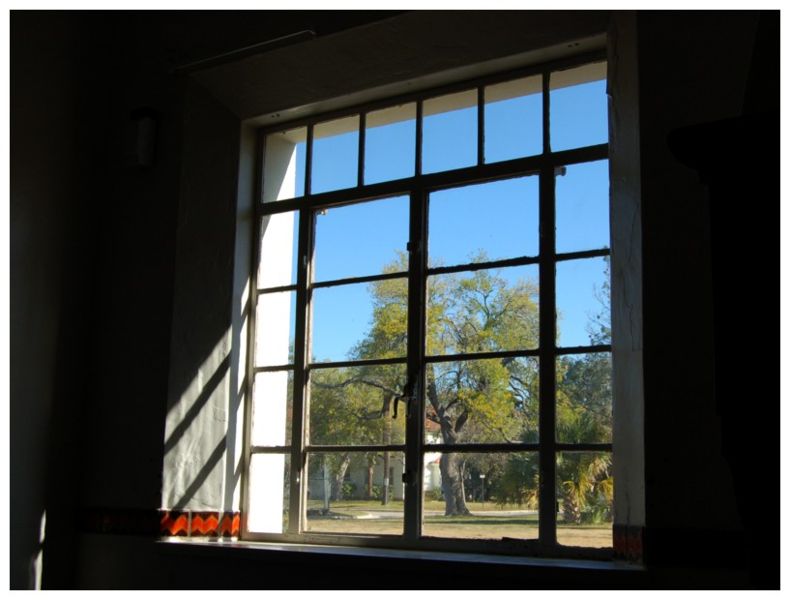 Stephen - I have to say the idea is not new. It has been put forward in the states in the 70's and 80s. The reason I came back to it was that I was looking at retrofitting thermal insulation on typical Victorian buildings. And I realised that these buildings had windows that were larger than the equivalent buildings today. I had seen new housing developments going on around our cities and realised that the windows there were getting smaller and smaller. And the reason is that windows let through a lot more heat than walls by a factor of 5-9 times. So in order to stop buildings letting out too much heat there is a real pressure on architects and designers to reduce the window area.
Stephen - I have to say the idea is not new. It has been put forward in the states in the 70's and 80s. The reason I came back to it was that I was looking at retrofitting thermal insulation on typical Victorian buildings. And I realised that these buildings had windows that were larger than the equivalent buildings today. I had seen new housing developments going on around our cities and realised that the windows there were getting smaller and smaller. And the reason is that windows let through a lot more heat than walls by a factor of 5-9 times. So in order to stop buildings letting out too much heat there is a real pressure on architects and designers to reduce the window area.
Helen - Yes I live in a Victorian house and I love the fact that our windows are nice and big, but I do worry that we loose a lot of heat across them because they are not double glazed. So what are these thermal shutters going to do to help that?
Stephen - Well the situation applies generally that we live in houses traditionally where we use windows to let in light, and as the windows get smaller and smaller we have to put our lights on. And we start using energy in lighting. And we start using in my mind rather nasty low energy fittings to get around that, and we get into a rather vicious declining spiral. And it struck me that perhaps we should look into the idea of turning our windows into walls when we are not there. And this is really interesting and research done by a colleague of mine on offices convincingly shows that we are not in our buildings for a large amount of time in a 24 hour cycle, and when we are in our homes at night when there is no external light. This all leads to the possibility of thinking perhaps we should put thermal shutters on the outsides of our buildings to essentially turn the windows into walls when we are not there.
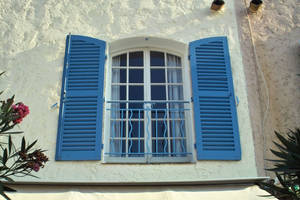 Helen - We have had shutters on traditional buildings, but traditionally made out of wood. Presumably you are thinking of using something more advanced than that.
Helen - We have had shutters on traditional buildings, but traditionally made out of wood. Presumably you are thinking of using something more advanced than that.
Stephen - Yes the kind of materials we are looking at, are the kind of materials which go into modern highly efficient fridges, especially fridge doors Where you can get the equivalent thickness of a well insulated wall inside something between 20-40mm thickness. Which makes these really not terribly big to open and close
Helen - Is the idea that you would open and close them yourself, or are they going to do it themselves?
Stephen - Well obviously the interest would be to have the things opening and closing on their own, but if they do this they have to have either some knowledge of your presence or the possibility that you can override them as they go on their way. I think that one thing one has to say, that if you are in a space, say your large Victorian living room, you it may be a bit cold outside, but if you are there, perhaps you don't mind loosing a bit of heat through the window.
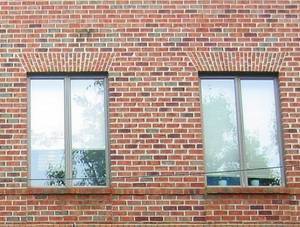 Helen - So it will be able to control itself to some extent. And this will help us in both summer and winter?
Helen - So it will be able to control itself to some extent. And this will help us in both summer and winter?
Stephen - That's right, because obviously if a shutter stops heat getting out of a window it will stop heat getting into a building and especially they will stop solar gain.
Helen - Also the idea of the fact that we are not in our building very much of the day. Is there going to get to a point where the window knows when you get home at the end of the day.
Stephen - Well there are plenty of intelligent systems which can tell when you are there. You can tell a window when you are coming home, people do this all the time already, with building management systems.
Helen - Are we already seeing these thermal shutters in use, or are they just in development?
Stephen - We've got a project where we are taking these into development of these with a commercial product. There aren't any standard products yet, although architects have used commercially available doors to achieve this effect.
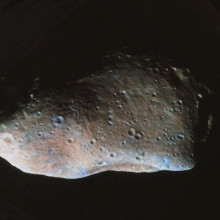
47:16 - Where on Earth is the safest place for an asteroid to hit?
Where on Earth is the safest place for an asteroid to hit?
We put this to Heather Jackson, National Museum of WalesIf you imagine the size of this potential asteroid it's perhaps ten kilometres across, similar to the one which fell in Mexico 65 million years ago. Wherever it hits it's going to be incredibly destructive. The most devastating impact is likely to be in the ocean because it potentially could cause tsunamis and the least destructive would be if it were to hit a poorly populated area, perhaps like Antarctica. The size of this object is something the size of Cardiff travelling at 25 times the speed of sound the compressed column of air travelling in front of it would heat the ground to almost as hot as the surface of the sun. The blast wave would kill anything within about 250km instantly. The real killer would be the atmospheric effects that would be caused by the vaporisation of rock, particularly if that rock contained large amounts of sulphur because that could lead to severe acid rain. Predictions as to the size of the waves produced if it fell in the ocean vary but it's clear that a large impact would drown coastal areas, which is where most of our population live. The pacific coast of Asia is a particularly deadly place for an asteroid to strike because of the population density there and the potential for tsunamis. Overall the worst effect would be caused by a meteorite falling into an ocean; perhaps not particularly deep, about 2km deep, causing a tsunami and then vaporising sea bed sediments which contain a lot of carbon dioxide and a lot of sulphur which would cause climate change for years to come.
- Previous Chuckling Chimps and Shining Squid
- Next Laughter, Smell and Sounds









Comments
Add a comment